Askeland D.R., Fulay P.P. Essentials of Materials Science & Engineering
Подождите немного. Документ загружается.

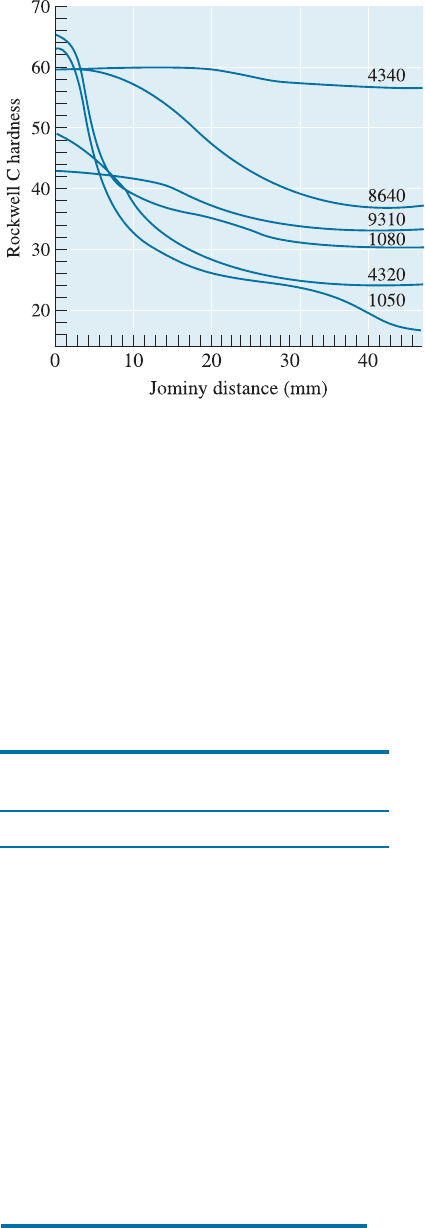
Virtually any steel transforms to martensite at the quenched end. Thus, the hard-
ness at zero Jominy distance is determined solely by the carbon content of the steel. At
larger Jominy distances, there is a greater likelihood that bainite or pearlite will form
instead of martensite. An alloy steel with a high hardenability (such as 4340) maintains
a rather flat hardenability curve; a plain-carbon steel (such as 1050) has a curve that
drops o¤ quickly. The hardenability is determined primarily by the alloy content of the
steel.
We can use hardenability curves in selecting or replacing steels in practical appli-
cations. The fact that two di¤erent steels cool at the same rate if quenched under iden-
tical conditions helps in this selection process. The Jominy test data are used as shown
in the following example.
Figure 13-21
The hardenability curves for several
steels.
TABLE 13-3 9 The relationship between cooling
rate and Jominy distance
Jominy Distance (mm) Cooling Rate (
˚
C/s)
1:6 315
3:1 110
4:750
6:336
7:828
9:422
10:917
12:515
15:610
18:88
25:05
31:33
37:5 2.8
43:8 2.5
56:3 2.2
C HA P T E R 1 3 Heat Treatment of Steels and Cast Irons410

EXAMPLE 13-5 Design of a Wear-Resist ant Gear
A gear made from 9310 steel, which has an as-quenched hardn ess at a critical
location of HRC 40, wears at an excessive rate. Tests have shown that an
as-quenched hardness of at least HRC 50 is required at that critical location.
Design a steel that would be appropriate.
SOLUTION
We know that if di¤erent steels of the same size are quenched under identical
conditions, their cooling rates or Jominy distances are the same. From Figure
13-21, a hardness of HRC 40 in a 9310 steel corresp onds to a Jominy distance
of 15.6 mm (10
C/s). If we assume the same Jominy distance, the other steels
shown in Figure 13-21 have the following hardnesses at the critical location:
1050 HRC 28
1080 HRC 36
4320 HRC 31
8640 HRC 52
4340 HRC 60
Both the 8640 and 4340 steels are appropriate. The 4320 steel has too low
a carbon content ever to reach HRC 50; the 1050 and 1080 have enough car-
bon, but the hardenability is too low. In Table 13-1, we find that the 86xx steels
contain less alloying elements than the 43xx steels; thus the 8640 steel is prob-
ably less expensive than the 4340 steel and might be our best choice. We must
also consider other factors such as durability.
In another simple technique, we utilize the severity of the quench and the Grossman
chart (Figure 13-22) to determine the hardness at the center of a round bar. The bar
diameter and H coe‰cient, or severity of the quench in Table 13-2, give the Jominy
distance at the center of the bar. We can then determine the hardness from the harden-
ability curve of the steel. (See Example 13-6.)
Figure 13-22
The Grossman chart used to
determine the hardenability at the
center of a steel bar for different
quenchants.
13-6 Application of Hardenability 411

EXAMPLE 13-6 Design of a Quenching Process
Design a quenching process to produce a minimum hardness of HRC 40 at the
center of a 3.75 cm diameter 4320 steel bar.
SOLUTION
Several quenching media are listed in Table 13-2. We can find an approximate
H coe‰cient for each of the quenching media, then use Figure 13-22 to esti-
mate the Jominy distance in a 3.75 cm diameter bar for each media. Finally,
we can use the hardenability curve (Figure 13-21) to find the hardness in the
4320 steel. The results are listed below.
H Coefficient Jominy Distance (mm) HRC
Oil (no agitation) 0.25 17.2 30
Oil (agitation) 1.00 9.4 39
H
2
O (no agitation) 1.00 9.4 39
H
2
O (agitation) 4.00 6.3 44
Brine (no agitation) 2.00 7.8 42
Brine (agitation) 5.00 4.7 46
The last three methods, based on brine or agitated water, are satisfactory.
Using an unagitated brine quenchant might be least expensive, since no extra
equipment is needed to agitate the quenching bath. However, H
2
O is less cor-
rosive than the brine quenchant.
13-7 Specialty Steels
There are many special categories of steels, including tool steels, interstitial-free steels,
high-strength-low-alloy (HSLA) steels, dual-phase steels, and maraging steels.
Tool steels are usually high-carbon steels that obtain high hardnesses by a quench
and temper heat treatment. Their applications include cutting tools in machining oper-
ations, dies for die casting, forming dies, and other uses in which a combination of high
strength, hardness, toughness, and temperature resistance is needed.
Alloying elements improve the har denability and high-temperature stability of
the tool steels. The water-hardenable steels such as 1095 must be quenched rapidly to
produce martensite and also soften rapidly even at relatively low temperatures. Oil-
hardenable steels form martensite more easily, temper more slowly, but still soften at
high temperatures. The air-hardenable and special tool steels may harden to martensite
while cooling in air. In addition, these steels may not soften until near the A
1
temper-
ature. In fact, the highly alloyed tool steels may pass through a secondary hardening
peak near 500
C as the normal cementite dissolves and hard alloy carbides precipitate
(Figure 13-19). The alloy carbides are particularly stable, resist growth or spheroidiza-
tion, and are important in establishing the high-temperature resistance of these steels.
High-strength-low-alloy (HSLA) steels are low-carbon steels containing small
amounts of alloyin g elements. The HSLA steels are specified on the basis of yield
strength, with grades up to 552 MPa the steels contain the least amount of alloying ele-
ment that still provides the proper yield strength without heat treatment. In these steels,
C HA P T E R 1 3 Heat Treatment of Steels and Cast Irons412
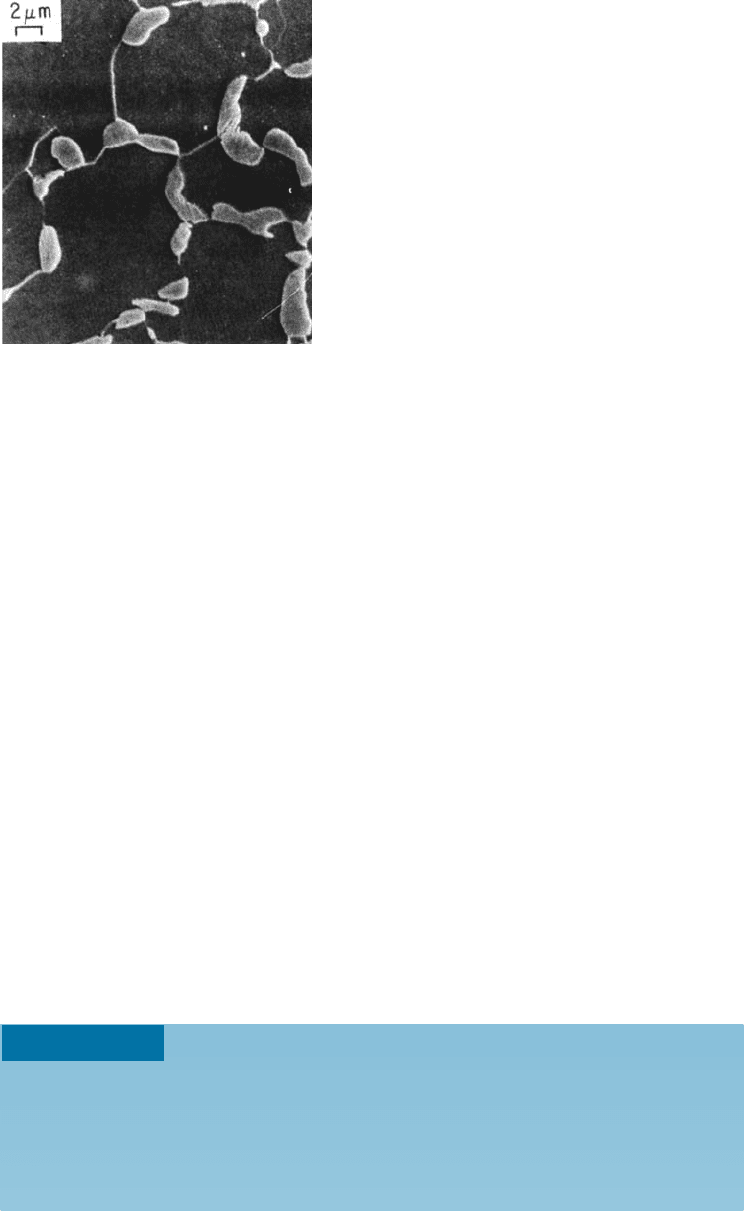
careful processing permits precipitation of carbides and nitrides of Nb, V, Ti, or Zr,
which provide dispersion strengthening and a fine grain size.
Dual-phase steels contain a uniform distribution of ferrite and martensite, with
the dispersed martensite providing yield strengths of 414 to 1000 MPa These low-
carbon steels do not contain enough alloying elements to have good hardenability
using the normal quenching processes. But when the steel is heated into the ferrite-
plus-austenite portion of the phase diagram, the austenite phase becomes enriched in
carbon, which provides the needed hardenability. During quenching, only the austenite
portion transforms to martensite (Figure 13-23).
Maraging steels are low-carbon, highly alloyed steels. The steels are austenitized
and quenched to produce a soft martensite that contains less than 0.3% C. When the
martensite is aged at about 500
C, intermetallic compounds such as Ni
3
Ti, Fe
2
Mo, and
Ni
3
Mo precipitate.
Interstitial-free steels are steels containing Nb and Ti. They react with C and S
to form precipitates of carbides and sulfides. Thus, virtually no carbon remains in the
ferrite and hence, the name interstitial-free steels. These steels are very formable and
attractive for the automobile industry.
Grain-oriented steels containing silicon are used as soft magnetic materials and are
used in transformer cores. Nearly pure iron powder (known as carbonyl iron), obtained
by the decomposition of iron pentacarbonyl (Fe(CO)
5
) and sometimes a reducing heat
treatment, is used to make magnetic materials. Pure iron powder is also used as an ad-
ditive for food supp lements in breakfast cereals and other iron-fortified food products
under the name reduced iron.
As mentioned before, many steels are also coated, usually to provide good corro-
sion protection. Galvanized steel is coa ted with a thin layer of zinc, terne steel is coated
with lead, and other steels are coated with aluminum or tin.
EXAMPLE 13-7
High Strength Microalloyed Steels for Petroleum Pipelines
At present, due to world wide increased demand for oil, there is a need to de-
velop exceptionally strong (yield strength of @800 MPa) steels for pipelines.
Such strong steels allow for operating the pipelines under higher pressures and
over a long distance. Such microalloyed steels often can contain such elements
as Mn, Nb, V, Ti, Mo, Ni, Cr, and Cu. [Ref. Microstructure and High
Figure 13-23
Microstructure of a dual-phase steel, showing
islands of light martensite in a ferrite matrix
(2500). (From G. Speich, ‘‘Physical Metallurgy
of Dual-Phase Steels,’’ Fundamentals of Dual-
Phase Steels, The Metallurgical Society of AIME,
1981.)
13-7 Specialty Steels 413

Strength–Toughness Combination of a New 700 MPa Nb-Microalloyed Pipe-
line Steel Materials Science and Engineering: A.S. Shanmugam, N.K. Ram-
isetti, R.D.K. Misra, J. Hartmann and S.G. Jansto (in press, 2007).] (a) What
other factors must be considered for high-strength steels for oil pipelines? (b)
Based on what you have learned in terms of mechanisms of strengthening, how
can you choose the best possible alloying elements for this application? Assume
that you can conduct whatever experiments are necessary.
SOLUTION
(a) O ne of the first considerations is that when we increase strength signifi-
cantly, is there a loss of ductility? The trick to developing such materials
is that they provide not just strength but also an adequate level of ductility
such that forming (e.g., rolling, extrusion, etc., Chapter 8) is still possible.
Another consideration is the possibility of these steels becoming brittle due
to incorporation of hydrogen or sulfur. We can also choose such alloying
elements as chromium, nickel, and copper, because they have been known
to provide adequate strength even in a corrosive environment (Sec-
tion 13-10). An additional consideration would be the weldability of the
steels and the microstructure both of the steel and of the area surrounding
the weld region (Section 13-9).
(b) We can get some strengthening due to solid-solution formation (Chap-
ter 10) and the formation of second phases (Chapter 12). We can also proc-
ess the steel so as to get a fine grain size to get the Hall-Petch strengthening
e¤ect (Chapter 4). The primary grain size of the ferrite that will form from
austenite is controlled by the grain size of the recrystallized austenite. We
can minimize the primary austenite grain size by using niobium. It is known
that niobium is a good carbide former. Fine precipitates of niobium carbides
will pin the boundaries of austenite and prevent it from grain growth
(Chapter 5).
To get exceptionally high strengths, we can resort to the formation of
nano-sized precipitates of a second phase in a soft matrix such as ferrite. The
choice of alloying elements that could be added can be guided by knowing
what forms of precipitates can form so as to get a significant level of precip-
itation strengthening. This strengthening mechanism can be achieved by
additions of not only niobium but also of titanium and vanadium. Care
must be taken to ensure that such precipitates are fine (<10 nm), coherent,
and high in number concentrations (Chapter 5). We can also study how such
an alloy is a¤ected as a result of the exposure to heat from the welding
processes that will be used. Will there be a heat-a¤ected zone (Chapter 9)
in which any precipitates formed may grow in size and thereby become in-
e¤ective in providing strengthening? Another important consid eration is the
cost and amounts of alloying elements needed; this must be optimized.
This example is meant to illustrate how the principles of what you have
learned so far are applied in an integrated fashion for developing a material
suitable for a given real-life application. Obviously, even with a team of expe-
rienced researchers and engineers from many disciplines, experimentation and
field testing are almost always required to develop a suitable and cost-e¤ective
material. It is not the inten t of this example to expect someone to just develop a
material simply by reading about the concepts.
C HA P T E R 1 3 Heat Treatment of Steels and Cast Irons414
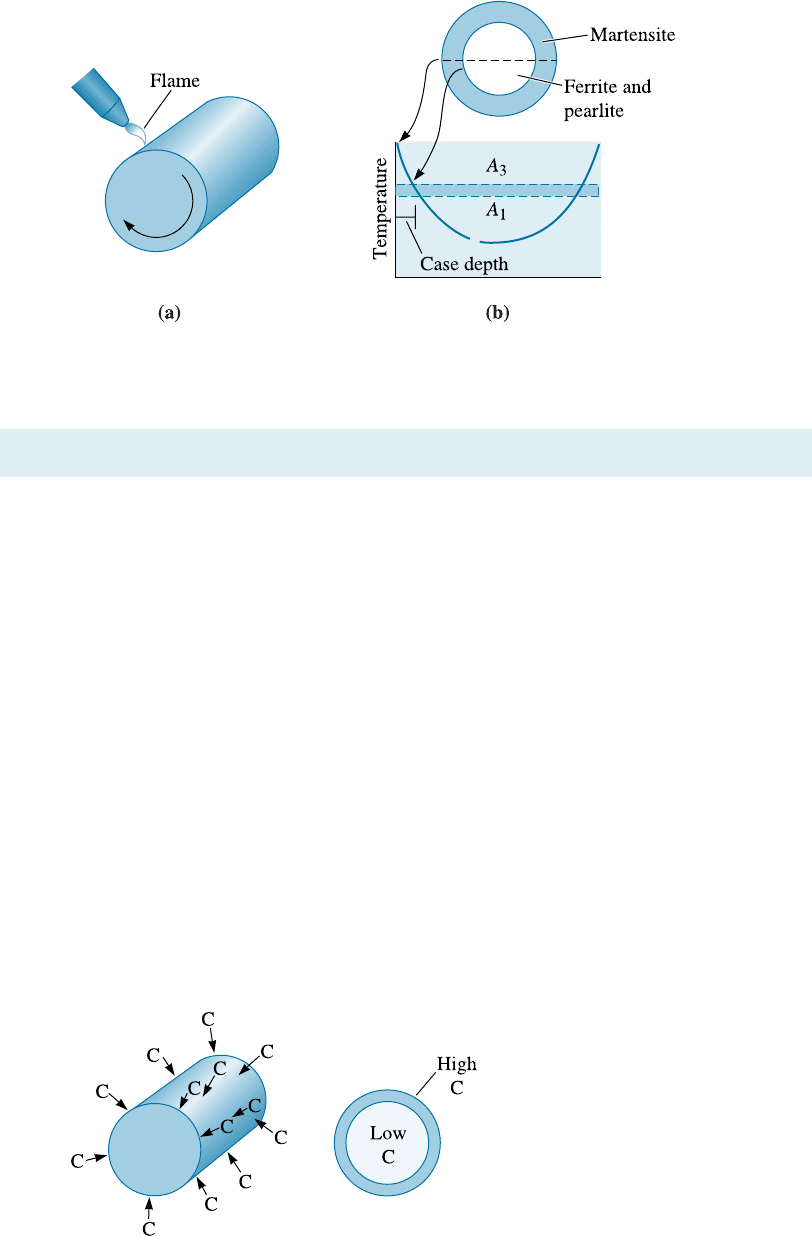
13-8 Surface Treatments
We can, by proper heat treatment, produce a structure that is hard and strong at the
surface, so that excellent wear and fatigue resistance are obtained, but at the same time
gives a soft, ductile, tough core that provides good resistance to impact failure. We have
seen principles of carburizing in Chapter 5, when we discussed di¤usion. In this section,
we see this and other similar processes.
Selectively Heating the Surface We could begin by rapidly heating the surface of a
medium-carbon steel above the A
3
temperature (the center remains below the A
1
). After
the steel is quenched, the center is still a soft mixture of ferrite and pearlite, while the
surface is martensite (Figure 13-24). The depth of the martensite layer is the case depth.
Tempering produces the desired hardness at the surface. We can provide local heating
of the surface by using a gas flame, an induction coil, a laser beam, or an electron
beam. We can, if we wish, harden only selected areas of the surface that are most sub-
ject to failure by fatigue or wear.
Carburizing and Nitriding These techniques involve controlled di¤usion of carbon and
nitrogen, respectively (Chapter 5). For best toughness, we start with a low-carbon steel.
In carburizing, carbon is di¤used into the surface of the steel at a temperature above the
A
3
(Figure 13-25). A high-carbon content is produced at the surface due to rapid dif-
fusion and the high solubility of carbon in austenite. When the steel is quenched and
Figure 13-24 (a) Surface hardening by localized heating. (b) Only the surface heats above the
A
1
temperature and is quenched to martensite.
Figure 13-25
Carburizing of a low-carbon steel to
produce a high-carbon, wear-resistant
surface.
13-8 Surface Treatments 415
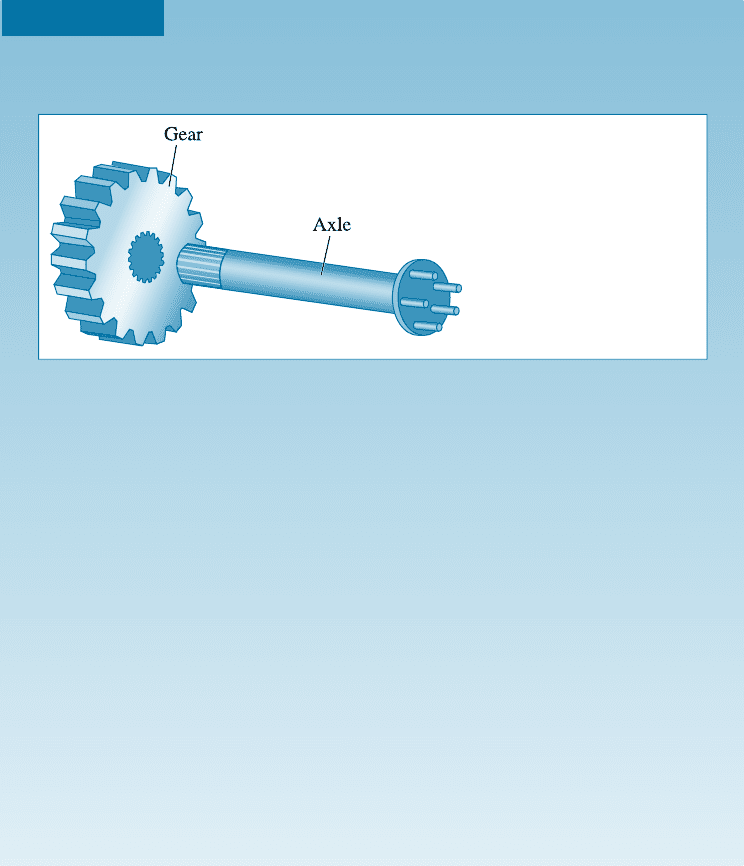
tempered, the surface becomes a high-carbon tempered martensite, while the ferritic
center remains soft and ductile. The thickness of the hardened surface, called the case
depth, is much smaller in carburized steels than in flame- or induction-hardened steels.
Nitrogen provides a hardening e¤ect similar to that of carbon. In cyaniding, the steel
is immersed in a liquid cyanide bath which permits both carbon and nitrogen to di¤use
into the steel. In carbonitriding , a gas containing carbon monoxide and ammonia is
generated and both carbon and nitrogen di¤use into the steel. Finally, only nitrogen
di¤uses into the surface from a gas in nitriding. Nitriding is carried out below the A
1
temperature.
In each of these processes, compressive residual stresses are introduced at the
surface, providing excellent fatigue resistance (Chapter 8) in addition to the good com-
bination of hardness, strength, and toughness. The following example explains consid-
erations that go into considering heat treatments such as quenching and tempering and
surface hardening.
EXAMPLE 13-8
Design of Surface-Hardening Treatments for a Drive Train
Design the materials and heat treatments for an automobile axle and drive gear
(Figure 13-26).
SOLUTION
Both parts require good fatigue resistance. The gear also should have a good
hardness to avoid wear, and the axle should have good overall strength to
withstand bending and torsional loads. Both parts should have good toughness.
Finally, since millions of these parts will be made, they should be inexpensive.
Quenched and tempered alloy steels might provide the required combina-
tion of strength and toughness; however, the alloy steels are expensive. An
alternative approach for each part is described next.
The axle might be made from a forged 1050 steel containing a matrix of
ferrite and pearlite. The axle could be surface-hardened, perhaps by moving the
axle through an induction coil to selectively heat the surface of the steel above
the A
3
temperature (about 770
C). After the coil passes any particular location
of the axle, the cold interior quenches the surface to martensite. Tempering
then softens the martensite to improve ductility. This combination of carbon
content and heat treatment meets our requirements. The plain-carbon steel is
inexpensive; the core of ferrite and pearlite produces good toughness and
strength; and the hardened surface provides good fatigue and wear resistance.
The gear is subject to more severe loading conditions, for which the 1050
steel does not provide su‰cient toughness, hardness, and wear resistance.
Figure 13-26
Sketch of axle and gear
assembly (for Example
13-8).
C HA P T E R 1 3 Heat Treatment of Steels and Cast Irons416
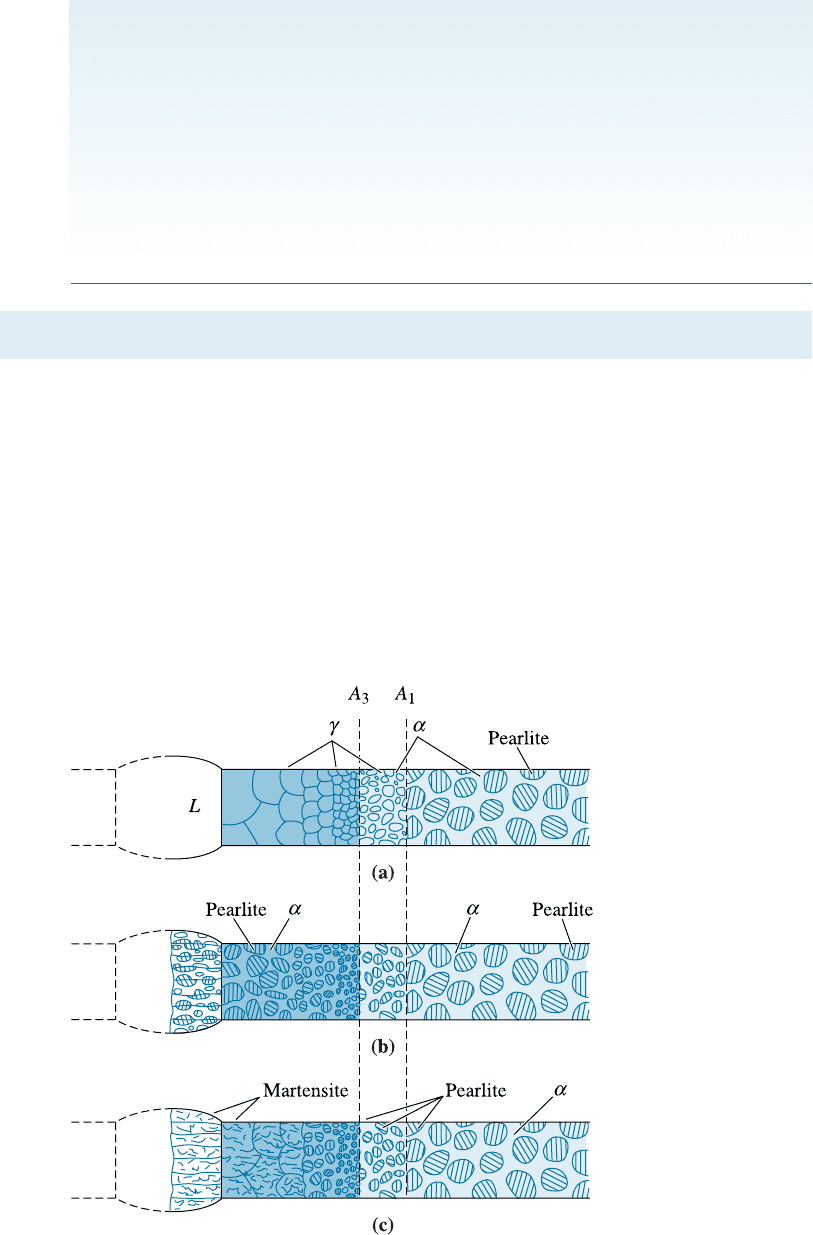
Instead, we might carburize a 1010 steel for the gear. The original steel contains
mostly ferrite, providing good ductility and toughness. By performing a gas
carburizing process above the A
3
temperature (about 860
C), we introduce
about 1.0% C in a very thin case at the surface of the gear teeth. This high-
carbon case, which transforms to martensite during quenc hing, is tempered to
control the hardness. Now we obtain tough ness due to the low-carbon ferrite
core, wear resistance due to the high-carbon surface, and fatigue resistance due
to the high-strength surface containing compressive residual stresses introduced
during carburizing. In addition, the plain-carbon 1010 steel is an inexpen-
sive starting material that is easily forged into a near-net shape prior to heat
treatment.
13-9 Weldability of Steel
In Chapter 9, we discussed welding and other joining processes. We noted that steels
are the most widely used structural materials. In bridges, buildings, and many other
applications, steels must be welded. The structural integrity of steel structures not only
depends upon the strength of the steel but also the strength of the welded joints. This is
why the weldability of steel is always an important consideration.
Many low-carbon steels weld easily. Welding of medium- and high-carbon steels is
comparatively more di‰cult since martensite can form in the heat-a¤ected zone rather
easily, thereby causing a weldment with poor toughness (Figure 13-27). Several strat-
egies such as preheating the material or minimizing incorporation of hydrogen have
been developed to counter these problems. The incorporation of hydrogen causes the
steel to become brittle. In low-carbon steels, the strength of the welded regions in these
Figure 13-27
The development of the
heat-affected zone in a
weld: (a) the structure at
the maximum temper-
ature, (b) the structure
after cooling in a steel of
low hardenability, and
(c) the structure after
cooling in a steel of high
hardenability.
13-9 Weldability of Steel 417

materials is higher than the base material. This is due to the finer pearlite micro-
structure that forms during cooling of the heat-a¤ected zone. Retained austenite along
ferrite grain boundaries also limits recrystallization and thus helps retain a fine grain
size, which contributes to the strength of the welded region. During welding, the metal
nearest the weld heats above the A
1
temperature and austenite forms (Figure 13-27).
During cooling, the austenite in this heat-a¤ected zone transforms to a new structure,
depending on the cooling rate and the CCT diagram for the steel. Plain low-carbon
steels have such a low hardenability that normal cooling rates seldom produce marten-
site. However, an alloy steel may have to be preheated to slow down the cooling rate or
post-heated to temper any martensite that forms.
A steel that is originally quenched and tempered has two problems during welding.
First, the portion of the heat-a¤ected zone that heats above the A
1
may form martensite
after cooling. Second, a portion of the heat-a¤ected zone below the A
1
may overtemper.
Normally, we should not weld a steel in the quenched and tempered condition. The
following example shows how the heat-a¤ected zone microstructure can be accounted
for using CCT diagrams.
EXAMPLE 13-9
Structures of Heat-Affected Zones
Compare the structures in the heat-a¤ected zones of welds in 1080 and 4340
steels if the cooling rate in the heat-a¤ected zone is 5
C/s.
SOLUTION
From the CCT diagrams, Figures 13-14 and 13-16, the cooling rate in the weld
produces the following structures:
1080: 100% pearlite
4340: Bainite and martensite
The high hardenability of the alloy steel reduces the weldability, permitting
martensite to form and embrittle the weld.
13-10 Stainless Steels
Stainless steels are selected for their excellent resistance to corrosion.
All true stainless steels contain a minimum of about 11% Cr, which permits a thin,
protective surface layer of chromium oxide to form when the steel is exposed to oxygen.
The chromium is what makes stainless steels stainless. Chromium is also a ferrite sta-
bilizing element . Figure 13-28(a) illustrates the e¤ect of chromium on the iron-carbon
phase diagram. Chromium causes the austenite region to shrink, while the ferrite region
increases in size. For high-chromium, low-carbon compositions, ferrite is present as a
single phase up to the solidus temperature.
There are several categories of stainless steels based on crystal structure and
strengthening mechanism. Typical properties are included in Table 13-4.
Ferritic Stainless Steels Ferritic stainless steels contain up to 30% Cr and less than
0.12% C. Because of the BCC structure, the ferritic stainless steels have good strengths
and moderate ductilities derived from solid-solution strengthening and strain hardening.
C HA P T E R 1 3 Heat Treatment of Steels and Cast Irons418
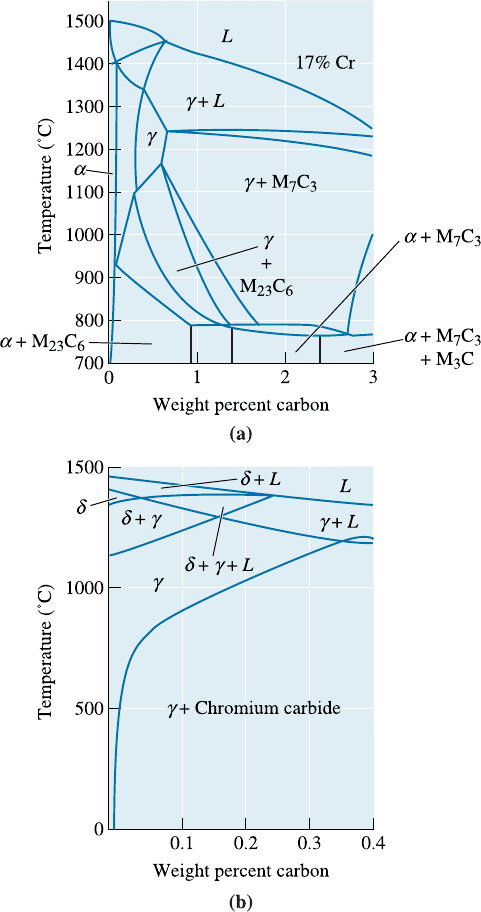
Ferritic stainless steels are magnetic. They are not heat treatable. They have excellent
corrosion resistance, moderate formability and are relatively inexpensive.
Martensitic Stainless Steels From Figure 13-28(a), we find that a 17% Cr-0.5% C
alloy heated to 1200
C forms 100% austenite, which transforms to martensite on
quenching in oil. The martensite is then tempered to produce high strengths and hard-
nesses [Figure 13-29(a)]. The chromium content is usually less than 17% Cr; otherwise,
the austenite field becomes so small that very stringent control over both austenitizing
temperature and carbon content is required. Lower chromium contents also permit the
carbon content to vary from about 0.1% to 1.0%, allowing martensites of di¤erent
Figure 13-28
(a) The effect of 17%
chromium on the iron-carbon
phase diagram. At low-carbon
contents, ferrite is stable at
all temperatures. (b) A section
of the iron-chromium-nickel-
carbon phase diagram at a
constant 18% Cr-8% Ni.
At low-carbon contents,
austenite is stable at room
temperature.
13-10 Stainless Steels 419
